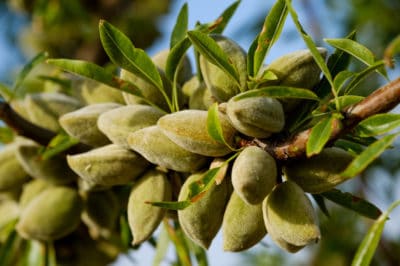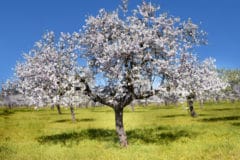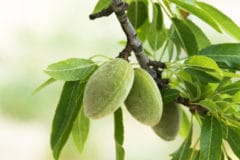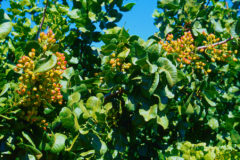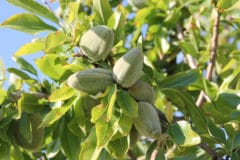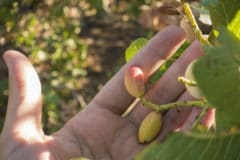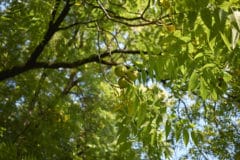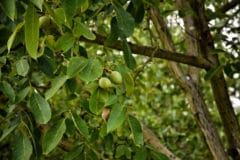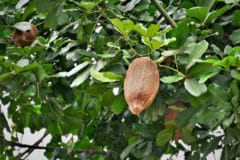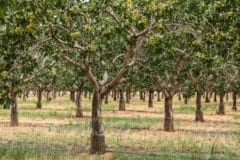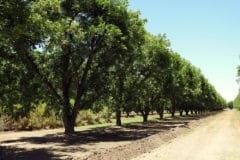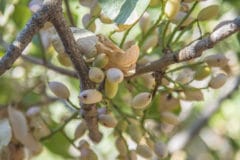True Nuts vs. Drupes
While true nuts and drupes both come from trees, their structures are very different. True nuts include acorns, hazelnuts and chestnuts. What makes them so are the hard pods encasing their fruits and seeds. As they ripen, the pods remains closed. Drupes have fleshy outer hulls that split when ripe to release inner shells encasing seeds or kernels.
Expert gardener’s tip: Cherries, peaches and mangoes are some drupes raised for their fleshy hulls. Almonds are raised for their seeds, or kernels.
Culinary Nuts vs. True Nuts
A phrase that could have been coined to describe Gordon Ramsay fans, “culinary nuts” simply refers to fruit with nut-like traits, such as seeds containing oily kernels. Hazelnuts are the only true nuts to qualify; chestnuts don’t have enough oil.
How Almond Drupes Develop
The ripe almond drupes harvested in late summer or early fall have been in the making for nearly a year. Without the thermometer cooperating in winter and spring, none of them would have made it.
This look at an almonds and their development is based on conditions in California’s Central Valley. Most of the world’s almonds are grown there in USDA plant hardiness zones 7 through 10.
Fall
As the post-harvest days of fall become colder and shorter, almond trees release growth-inhibiting enzymes, drop their leaves and store their energy and nutrients in their wood. This dormant state lets them survive winter cold.
Winter
Until spending sufficient number of hours between 33° and 45°F (0.55° and 7.2°C) breaks down their growth inhibitors, the trees remain dormant. Without these chilling hours, they can’t produce the buds that become flowers and drupes. The number of hours needed varies among cultivars, from around 250 to more than 500.
Expert gardener’s tips:
- In an ideal almond growing climate, the winter chilling hours exceed a tree’s requirements. This encourages more buds, flowers and drupes.
- If an unexpectedly mild winter doesn’t provide enough chilling hours, the trees’ male and female flowers may not be synchronized for pollination.
Spring
For almonds, spring – and the end of dormancy – begins much earlier that it does for other drupe trees. In the Northern Hemisphere, it comes in February when flower buds appear on the previous year’s shoots. The buds survive brief cold snaps down to 21°F (-6.1°C). Once they bloom, however, anything lower than 29°F (-1.6°C) will decrease the harvest.
Summer
During early summer, the drupes’ protective hulls begin to harden as the edible almond kernels get heavier. When the drupes finish growing, their hulls begin to split and reveal the inner almond shells. The nuts start drying and the drupes’ stems begin pulling away from the branches. By August or September, they’re ready to harvest.
What Almond Trees Need
The biggest, healthiest and tastiest almonds come grown with plenty of organic TLC. In addition to their chilling hours, they need a hot, dry climate with at least 20 inches of annual rainfall. Tropical climates don’t get cold enough but parts of Arizona, Texas, New Mexico, Nevada and even Oregon have suitable growing conditions. No matter where you are, success begins with planting the right trees.
Choosing Your Cultivars
Most almond cultivars need cross-pollination from a different cultivar in order to set fruit. Unless you have the room and time to grow more than one tree, stick with one of these two self-pollinating varieties, reliably hardy in USDA zones 7 through 10:
- Semi-dwarf ‘All-in-One’ stands 12 to 16 feet high at maturity, but can be maintained at 8 feet with regular summer pruning. It’s reliably hardy in USDA zones 7 through 10. ‘All-in-One’ needs 500 chilling hours and can cross pollinate all other almond cultivars.
- Ideal for small gardens and warm-winter climates, ‘Garden Prince’ grows just 8 to 12 feet tall and requires only 250 chilling hours.
Choosing a Planting Site
Almond trees need at least six hours of direct daily sun; a shade-free planting site is ideal. They like light, deep well-draining soil that resists waterlogging. It should have hardpan or rocks to a 3-foot depth and a pH between 5.8 to 7.0.
Planting Your Tree
To minimize heat stress, choose a cool, cloudy day for planting. Water your tree well, let it drain and then:
- Dig a hole twice as wide and the same depth as the tree’s container.
- Untangle and spread the rootball.
- Set the tree in the hole so that the top of the rootball extends slightly higher than the rim. This allows it to settle,
- Backfill the hole with soil, tamping lightly as you work to remove air pockets.
- Encircle the hole with a 2-inch mound of excess soil. This creates a basin around the tree.
- Water thoroughly. If the soil settles below the rim of the hole, add more to level it.
Continuing Care
Given consistent, proper care, most almond cultivars produce their first harvest in two to four years after planting. Watering, feeding, pruning and pest control all have roles in getting you the biggest harvest in the shortest time.
Watering
A newly planted almond tree needs 2 to 3 inches of water every week until it puts out new growth. That’s between 12 and 18 gallons (45 to 68 liters) for every 10 square feet of soil in each watering session.
After the roots have established, adjust your watering seasonally and always include rainfall totals in the suggested amounts. Otherwise, your tree will become waterlogged!
- From the time the buds begin swelling in spring until the drupes appear, give the tree 1.1/2 inches (9 gallons or 34 liters) of water every two weeks.
- As the drupes ripen from early to late summer, increase the water to 3 to 4 inches (18 to 24 gallons or 68 to 90 liters) every two weeks. Stop watering two weeks before your expected harvest date, so the tree’s bark will be dry enough to withstand damage during shaking.
- In the first two months after harvesting, gradually reduce the water from 2 or 2 ½ inches (12 to 15 gallons or 45 to 56 liters) to 1 inch (6 gallons or 22 liters) every two weeks. By November, ½ inch (3 gallons or 10 liters) of bi-weekly water is enough.
- During winter dormancy – and only if the winter is dry – provide 1 inch (6 gallons or 10 liters) of water once a month.
Expert gardener’s tip: For maximum absorption, water your tree slowly and deeply with a soaker hose or drip system.
Fertilizing
Begin fertilizing your tree in the first year after planting. Before it shows new spring growth, apply 1 cup of organic, slow-release 10-10-10 fertilizer for each year of its age, up to 10 cups. In fall, switch to 1 cup of calcium nitrate for every year, up to 4 cups. Skip this application if it hasn’t produced a harvest.
Pruning
Prune your tree’s dead or damaged branches at any time. During winter, prune to remove crossing, vertical or low-hanging branches. Winter is also the time to shape the canopy and maintain the size by trimming the limbs back to lateral shoots. To minimize the chance of fungal infection, always prune when no rain is forecast for at least a week.
Expert gardener’s tip: For the first few years after planting, leave your tree’s lower branches intact. They shade its trunk and boost its growth.
Pest Control
Your almond tree’s greatest pest threat comes from navel orangeworms. The hatch for the eggs silvery gray moths deposit on ripening drupes and in mummy nuts left behind in the previous harvest. To discourage an infestation, remove all mummy nuts from the tree and surrounding soil and seal and dispose of them in plastic bags.
